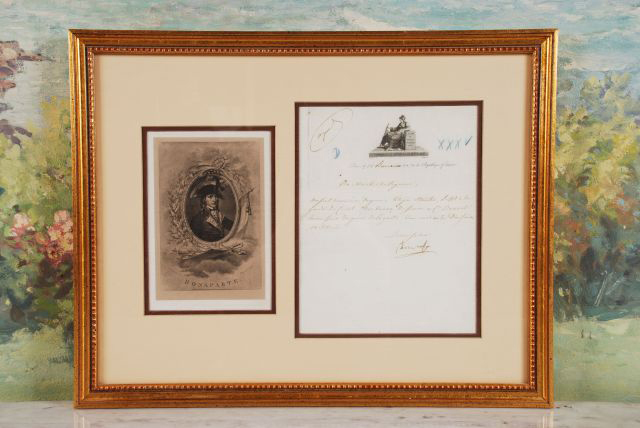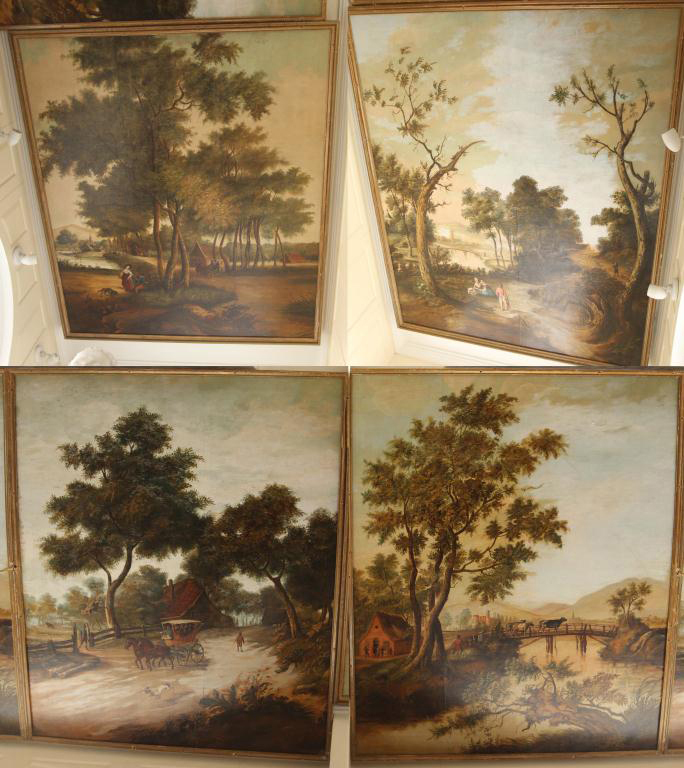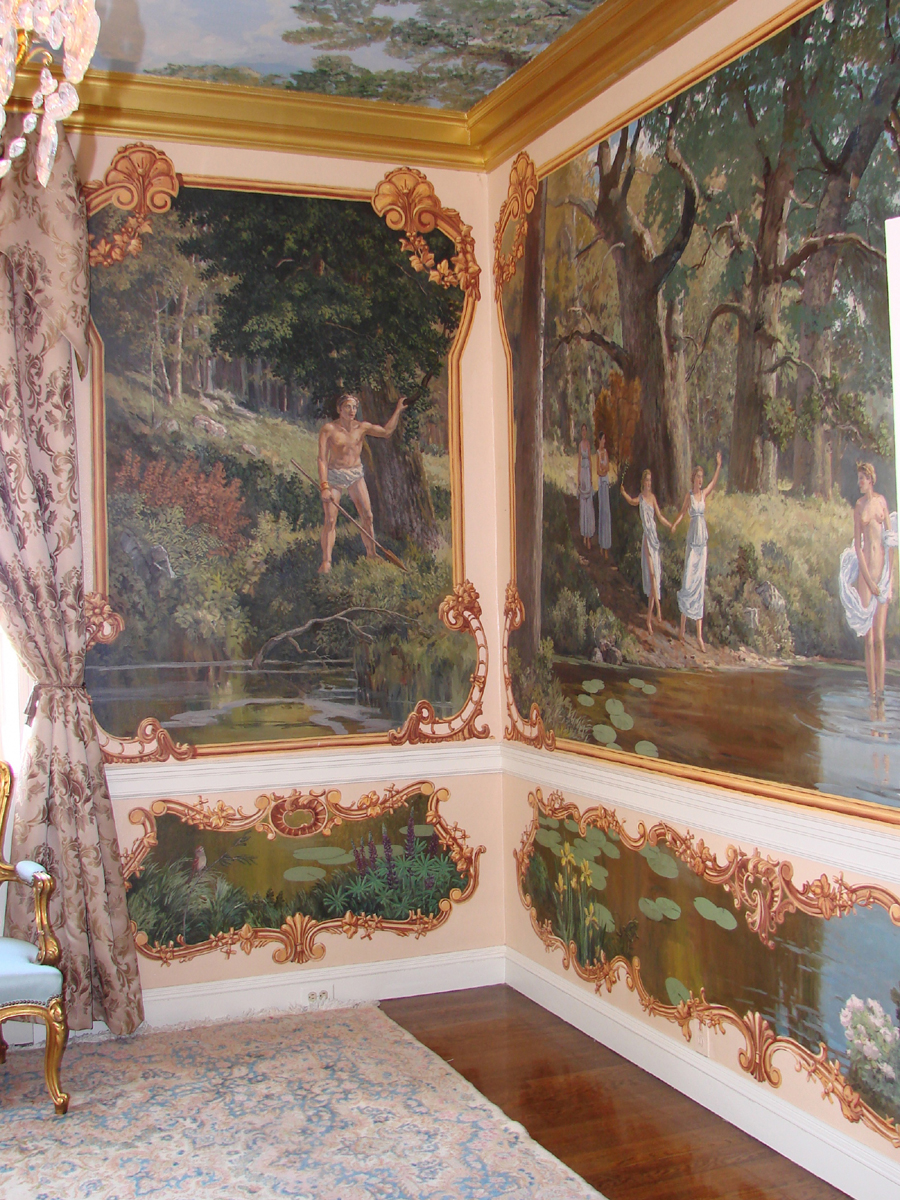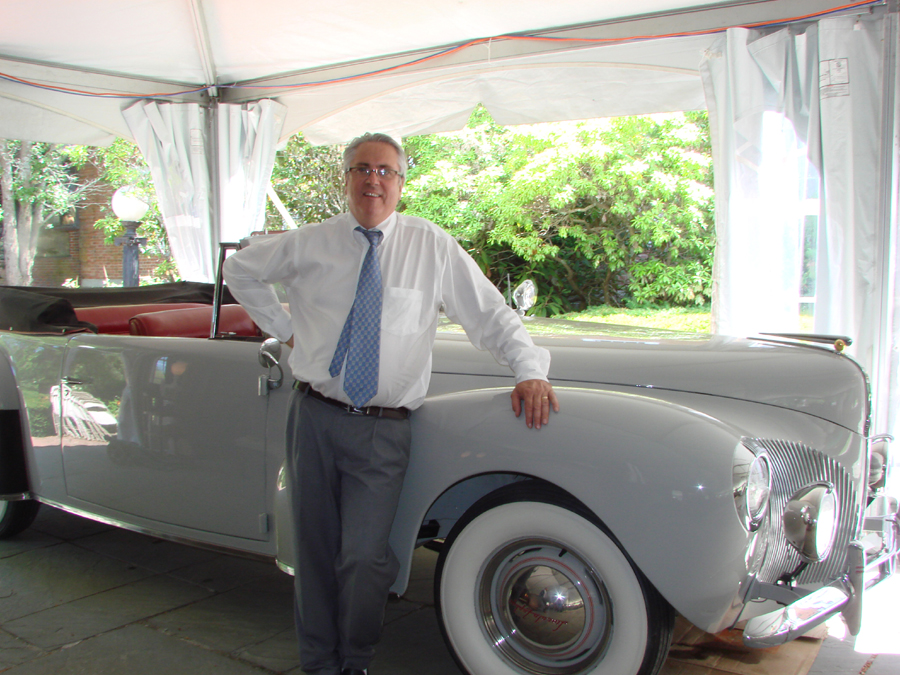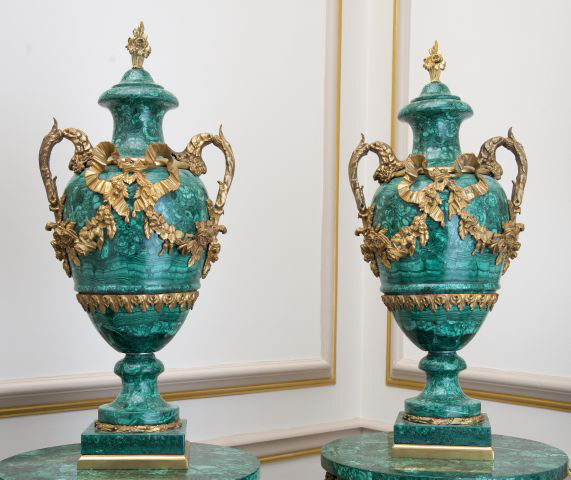
A pair of classical malachite, bronze mounted covered urns, 28 inches tall, reached $15,600. As with nearly all the malachite furniture and accessories, this pair did well over the estimate.
Review by Rick Russack, Photos Courtesy John McInnis Auctioneers.
WENHAM, MASS. — You can’t get a feeling for the collection that John McInnis sold July 1–2 without looking at some of the interior photos of the home taken before the auction. The home had 30 rooms and was set on 30 acres of land in Wenham, a small town in eastern Massachusetts settled in 1643. The neighborhood has long been considered an “equestrian” enclave, given the fact that the Myopia Hunt Club is just a couple of miles away. The club still conducts fox hunts, although without a real fox, and polo is still played every Sunday during the summer on one of the oldest polo fields in the country.

Henry Audesse moved into the 30-room brick mansion about 1983. It sits on 30 acres, with landscaped gardens, statuary and brick walkways. There was a staff of three and the real estate taxes were more than $50,000 a year.
The brick home, named Seven Pines, was built in 1927 and Henry D. Audesse moved in about 1985. He was truly a “self-made” man, having taken a job driving a bread delivery truck after being discharged from the Navy at the end of World War II. He started in the construction business, moved on to real estate and property development, and the rest, as they say, is history. Major development projects included Pickering Wharf in Salem, Mass., where he also owned the Hawthorne hotel. He died last year at the age of 93. The contents of the home sold for $2,040,000.
Audesse had an affinity for objects made of stone and marble statues, some of which were on pedestals displayed throughout the house and grounds. One incredible room of the house, aside from upholstered furniture, was completely furnished with furniture made of, or veneered with, malachite, a bright green mineral that was mined in Russia and today is mined in the Congo and other places. Several of the rooms had painted ceilings, marble floors and murals on the walls. The landscaped grounds include a smaller brick house, a pool house and a large greenhouse. It took a staff of three to care for the house, and the real estate taxes were more than $50,000 per year. One would assume that a home like this would be furnished with the best of the best, coinciding with the owner’s tastes, and it was.
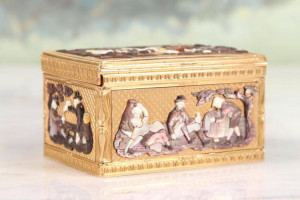
The highest priced item in the sale was this Eighteenth Century small gold snuff box with three French hallmarks. It was covered on all surfaces with scenes, carved in mother-of-pearl and abalone. It was just 3¼ inches wide and realized $36,000.
In a conversation with Nancy Audesse, Henry’s wife, she told Antiques and The Arts Weekly that the collection reflected her husband’s tastes and interests, and his French heritage. “The collection was his — he made the selections. My job was to make everything look good in the house. We did most of the buying in New York, with two or three dealers who knew what we wanted, and we also bought locally when there was something that Henry wanted. He really loved malachite, and there were objects made of it all over the house.”
When asked what her favorite item in the house was, she pointed to a large oil painting of the Three Magi, hanging over a mantel in the paneled library. “I think that painting is my favorite thing. This was the room we spent the most time in and I still remember Henry in front of that painting.” Before the start of the second day’s sale, Nancy said, “Yesterday went well. John [McInnis] did a good job. He and Henry had been friends for years. He was just the person to handle this auction.”
The top lot of the sale, selling for $36,000, was a small Eighteenth Century gold snuff box, with carved mother-of-pearl and abalone figures on all surfaces. It had three French hallmarks. The collection included numerous pieces of French furniture and clocks, marble statues, bronzes, oil paintings, porcelains, pietra dura, micromosaics, silver and items relating to Napoleon. Prices for many items exceeded estimates.

There are five pieces of malachite, or malachite veneered pieces of furniture in this photo. There were several more in the room named
the “Malachite room.”
Bidders were on the phone from several European countries, and at least one London dealer, representing Guinevere Antiques, flew over specifically for the sale. He bought heavily on the first day of the auction. The sale started off with a colorful pair of unsigned late Nineteenth Century 32-inch marble busts of Roman emperors. The busts were displayed on marble pedestals immediately inside the entrance to the home. Comprised of onyx and porphry, with other marble reserves, the pair brought $19,200.
A little later in the auction, a very large marble bust of Zeus, dating from the Nineteenth Century, sold for $32,400. A marble bust of Napoleon’s sister, Pauline Borghese, as Venus, achieved $4,800, and a marble bust of Beethoven finished at $3,000. Marble busts need marble pedestals and several were included in the sale. Most sold under $1,000 but a few brought more. A deeply carved Carrara marble pedestal, 53 inches tall, earned $1,920.
Almost all of the malachite veneered furniture sold over the high estimates. A Regency-style bureau plat, with malachite veneer, realized $21,600. A French Empire, ormolu mounted center table, with malachite veneer, achieved $18,000, against a $9,000 estimate, and a pair of Russian malachite, classic-form urns, 28 inches tall, brought $15,600, nearly twice the estimate. Not all brought five-figure prices. A small malachite lady’s hand mirror sold to an internet bidder for $330. The room with the malachite furniture and accessories had faux malachite cove molding around the ceiling as well as a faux malachite mantel. The visual effect was stunning.

At $32,400, this 42-inch expressive marble bust of Zeus was the highest priced sculpture in the sale.
Most of the 30 rooms in the house included French furniture, case pieces as well as upholstered pieces, and there were several fine French clocks. It would appear that the market and interest is strong for this material. A pair of Napoleon III-style cabinets, with ormolu mounts and inlaid pewter and engraved brass boulle panels, reached $32,400, more than tripling its estimate. With inlaid Sevres plaques, a Nineteenth Century ebonized cabinet went for $13,200, and a Louis XVI-style ormolu mounted leather top desk achieved $10,800.
A Louis XVI-style pedestal clock on an ornate ormolu mounted pedestal earned $18,000, and a Louis XV ormolu mounted mantel clock, having classical figures, realized $10,800. There were several pieces of pietra dura furniture made with inlaid hardstone and several framed micromosaic panels. A Nineteenth Century Grand Tour center table, 31 inches in diameter, with seven inlaid micromosaic medallions, finished at $13,200, and a framed Roman micromosaic plaque from the same time period made $8,400. Micromosaic panels were made utilizing thousands of tiny pieces of glass, or enamels, to create very detailed and colorful portraits or scenes. Both pietra dura furniture and micromosaic items were popular with Grand Tour shoppers in the Nineteenth Century.
Henry Audesse admired Napoleon and collected bronzes, porcelains, paintings, books and letters relating to him. A Nineteenth Century bronze of a mounted Napoleon sold for $2,400, a framed letter for $2,700, a Nineteenth Century marble bust for $1,440, and a Nineteenth Century Austrian porcelain charger, depicting Napoleon, finished at $840. A pair of 17-inch Sevres covered jars depicting Napoleon and Josephine, with ormolu mounts and Chateau marks, reached $4,200. A portrait of Napoleon by Horace Robbins Burdick (American, 1844–1942) fetched $960.

One of the major pieces in the malachite room was this Louis XVI-style vitrine. It had malachite veneer, two shaped glass shelves, ormolu mounts and earned $12,000.
Several silver items were sold. A Louis XVI sterling tray with chased portraits of Louis and Marie Antoinette sold for $2,400. A Nineteenth Century silver coffee/tea service marked “EP” for Emile Puiforcat, who founded his company in Paris in 1820, went out for $6,000. European porcelains included Sevres, KPM, Meissen, pate-sur-pate, as well as Limoges dinner services. A circa 1880 KPM pate-sur-pate portrait charger with a classical maiden sold for $6,300, and a Nineteenth Century pair of ormolu mounted Sevres vases, with mythological figures painted on a cobalt ground, went for $14,400. A Nineteenth Century ormolu mounted yellow Sevres covered urn, with winged angel handles, depicting Diana surrounded by putti, brought $1,920, while a pair of Eighteenth Century Sevres open chalices, with ormolu handles and scenes of children, realized only $1,080.
Books, almost all leather bound, were sold section by section in the paneled library, nine shelves to a section. Prices ranged from $1,680 per section to $3,000. Some of the walls were hung with tapestries. A Nineteenth Century example, 12 by 8 feet, depicting a park scene and a castle, finished at $10,800. Several large mirrors hung throughout the house; a 62-by-58-inch oval mirror with a crest of putti holding a lady, achieved $7,200.
The real estate, including 30 acres of land and outbuildings, was offered in the middle of the first day. McInnis announced that the final bid would be subject to the approval of the trustee, who was present. The high bid, $1,500,000, was declined by the trustee and the bidder and trustee discussed the bid. The bidder later told Antiques and the Arts Weekly that he was unable to reach a deal. “There was an appraisal in February and the figure was over $4,000,000. We’re not going to be able to make a deal.” As of this writing, McInnis said there is interest in the house from other parties.
McInnis and Dan Meader, gallery director, did an outstanding job of staging the auction. Meader said that he made a point of grouping like objects together, even though they might not have originally been displayed that way in the house. Instead of just piling up dinner services and glassware, as is often done, Meader and his crew used some to set very large dining tables, as though dinner parties were about to happen in each of the two dining rooms. Although the auction was conducted under a tent, McInnis allowed prospective buyers to enter the house to view and examine objects as the auction was in progress. After the sale, McInnis said, “I’d hate to tell you how much time went into getting this sale ready. We started working here during the winter and some of the pictures of outdoor statuary, that we used in the online catalog, were taken with snow on the ground. I knew Henry since the 1980s when I delivered a piece of furniture he bought from me at a show. We became good friends and I was really glad to be able to handle this sale.”
All prices reported include the buyer’s premium. For information, 978-388-0400 or www.mcinnisauctions.com.





